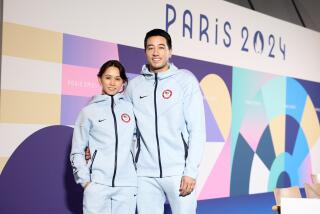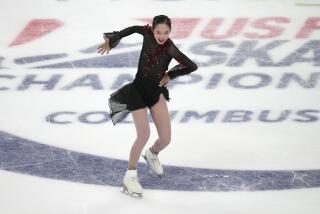But Can They Vow Judges? : Meno and Sand Make a Lovely Pair
- Share via
BIRMINGHAM, England — Todd Sand has been grabbing his partner by the hand, swinging her round and round and tossing her to and fro for a good three years now, but something in the air is different today.
Namely his partner, Jenni Meno.
Soon to be known in polite society as Mrs. Todd Sand.
That’s the fiancee up there, Sand has to remind himself as the best U.S. figure skating pair whips through another routine and gravity begins to take its toll on Meno.
Here comes the bride.
Catch her now, or the relationship could very well suffer.
As they prepare for today’s short program at the World Figure Skating Championships, Meno and Sand represent something altogether different in U.S. pairs competition. Engaged to be married in July, they are also engaged to return home with a medal in hand, thus breaking two longstanding American ice skating traditions.
In the States, figure skating pairs have a built-in obsolescence. They often begin in contrived harmony--two flagging solo careers lashed together to see if four legs glide better than two--and are made to be broken, generally after the third year, frequently after a 14th-place showing at the Worlds, at which point the other partner is blamed, then dismissed, then replaced. Then, the entire process begins anew.
Fact: No U.S. pair has won a medal in a Winter Olympics since 1988.
Fact: No U.S. pair has won a medal in the World Championships since 1991, when Sand and Natasha Kuchiki finagled a bronze, almost by accident, by staying on their feet while more renowned teams crashed around them.
Fact: Russia, which has a death grip on the event, has won nine of the last 10 World Championships, thanks largely to a national system that pairs skaters at 6 or 7 and keeps them together for years--and sometimes for a lifetime, for better or worse. Seven of the last nine Olympic gold medals have been won by married Russian couples.
Meno and Sand know the facts, although they aren’t getting hitched simply to enhance their victory-stand prospects.
Truth is, Meno and Sand were romantically linked before they were athletically linked, and in 1992, the news of their on-ice partnership passed for figure skating scandal--or as close as the sport could manage, pre-Tonya.
Through the Albertville Olympics and 1992 World Championships, Meno and Sand skated as opposite halves of competing pairs. Meno was teamed with Scott Wendland, Sand with Kuchiki, and the four of them trained at the same facility, Ice Capades Chalet in Costa Mesa, under the same coach, John Nicks, the former English world champion.
“You had both pairs training at the same rink, seeing each other almost every day,” Sand says. “Jenni and I had a good relationship, we were friends. But at the Olympics, we spent a lot of time together, especially after our event was over.
“We went to see some hockey games together. We’d go to the speedskating. Something clicked, although neither one of us really realized yet. Does that make sense?
“We came home a lot closer than when we left. A lot closer.”
Nicks jokes that “in the Olympic village, things other than training often take place.”
But he was oblivious at the time, and so apparently were Wendland and Kuchiki. When Meno returned to Costa Mesa five days after the 1992 World Championships and announced she was shaking up the lineups a tad, Wendland and Kuchiki, in Nicks’ words, were “stunned. Shocked. Aghast. Surprised. I can go through the whole dictionary for you.”
Sand: “Things were a little tense for a while.”
Meno: “A lot of people were saying, ‘You’re breaking up two very good American pairs teams--and now there’s only going to be one.’ And nobody knew if we were going to be good together. We knew it, we thought it. But a lot of other people were very, you know, ‘Oooohhh. ‘ “
Kuchiki-Sand and Meno-Wendland were very good by U.S. standards only. The teams placed sixth and 11th, respectively, at the Olympics and eighth and 11th at the Worlds. Nothing worth disbanding on the spot over, but nothing worth carving in stone, either. And, besides, romance was blooming.
“When we look back on it, in a way we took a really big risk,” Sand says. “But we decided we had the same goals. We had the same interest in music, in choreography, and we both wanted an extended career in skating, to finish as professionals.
“Those were things we really wanted to do. We took a chance. We’d never skated on the ice together and now we were deciding, ‘We’re going to be a pair.’ ”
Three years and two U.S. championships later, the match could have been predestined. At barely 5 feet and 96 pounds, Meno is smaller than Kuchiki, making throws and lifts easier for Sand. At 24, she is also closer in age to Sand, who is 31, nearly twice as old as Kuchiki.
With their red hair and fair complexions, Meno and Sand even look alike.
“Most people ask if we’re brother and sister,” Meno says with a giggle.
This draws a grimace from Sand, and a silver lining from Nicks, who notes, encouragingly, that it “makes costuming easier. They look good in the same colors.”
Flawless, by some accounts. At last month’s U.S. championships, Meno and Sand received five perfect scores of 6.0 for artistic presentation--unprecedented for a U.S. pair.
“The best back-to-back short and long programs by athletes of mine in my 30 years of coaching,” Nicks says.
The engagement ring, Meno believes, has a good deal to do with it.
“The way we feel for each other, the way we feel together comes across in our skating, I think,” she says.
A July 22 wedding date is set in Cleveland, Meno’s hometown, with a Maui honeymoon to follow. Prenuptials will be done here, and the agreement is this:
Any valuable metal brought back from England is to be shared, jointly and evenly.
More to Read
Go beyond the scoreboard
Get the latest on L.A.'s teams in the daily Sports Report newsletter.
You may occasionally receive promotional content from the Los Angeles Times.






